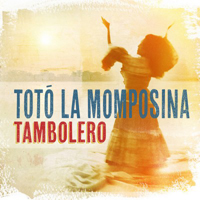
TOTO LA MOMPOSINA
TAMBOLERO (Realworld Gold CD209)
It's a great pleasure to write up this Totó la Momposina album because it is a reworking of her excellent debut La Candela Viva on the RealWorld label that compelled our attention 25 years ago. And it's not just the birth of a legend, it's the birth of two legends (because Batata is on there also). RealWorld are celebrating their anniversary by revisiting their catalogue and so far this has proved very fruitful. Totó, who is also about to celebrate an anniversary -- of 60 years as a performer, is a folklorist and scholar. From an early age she sang and danced in her mother's dance troupe, even as her native country Colombia was undergoing a civil war. Not only were the arts neglected but there was outright racism towards the African roots that she and her troupe were struggling to preserve. (She first heard of England in school when a charity delivered tins of hard cheese that she understood were a gift from the Queen of England!) When the WOMAD festival began in England Peter Gabriel, one of the organizers, had the idea of inviting selected acts down to his studio in rural Wiltshire to record a live album. Totó and her Tambores visited in 1991 and 1992 and laid down sets of Tambores, Sextetos and Gaitas, which are mostly vocal and percussion tracks. There are flutes (gaita) and even guitar and tiple (12-string guitar) on a couple of tracks. For the remixed album one track has been dropped and two added from the original master tapes. I compared the discs and it does sound richer. The liner notes say there was some overdubbing and choral additions by Totó's grand-daughters. Some of La Momposina's tunes have become classics, remixed by other bands, but also cherished as pure expressions of the blend of African, native and Spanish strains found uniquely in Colombia. The great international breakout sound known as Champeta began with Batata who was principal drummer in this group (heard on three tracks) before leaving to form his own Rumba Palenquera. "El Pescador" is a popular cumbia, composed by José Barros, that tells of the humble fisherman: "El pescador habla con la luna / habla con la playa / no tiene fortuna solo su atarraya (The fisherman speaks to the moon, he speaks to the beach, his fortune comes only from his net)." "La sombra negra (black shadows)" is a beautiful sextet with guitar and tiple that sounds Cuban, which it is because runaway African slaves from Cuba brought the songs with them. They built palenques, which were fortified villages in the jungle. The song, written by "Batata" Paulino Salgado, urges you to run run from the black shadow. To my mind "Dos de Febrero" and "Malanga" which come up next are both classics. The latter is in fact a remake of "Anabacoa" which was a hit for Perez Prado and Beny More back in their day. Batata is beating the daylights out of his tambor on the latter. The album ends with two sacred songs from the palenques, passed down to Batata by his father, also a master drummer.
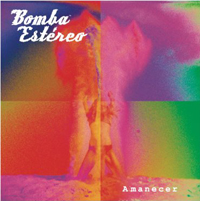
BOMBA ESTEREO
AMANECER (Bigdeal Sony Latin Records)
In their career Bomba Estereo have covered a lot of ground, adding electronic beats to various folk styles and suggesting everything from Berber music around a crackling fire to wacky Rajasthani puppet shows with whistling accompaniment. Their solid rhythm-machine tracks are augmented by live drums, then guitar and synth back engaging lyrics: this has endeared them to clubbers worldwide. Some questions arise with the new Bomba Estereo album. First, going back to their emergence in the early oughts, did their name and sound come from Azul Azul's hit "Bomba" which swept Latino America in the late 90s? They have been touring incessantly since their third album, Elegancia Tropical (maybe since their first album in 2007!), so when did they write this material? On stage, or in hotel rooms? Singer Li Saumet was living in New York last I read so how did they rehearse? Upside to Sony deal: this should break them worldwide; downside: no lossless downloads. Their familiar techno-folk cumbia-flavored sound has given way to super pop, or Uber-pop with confessional, existential lyrics and angst-tinged delivery from Li (as in "Alma y cuerpo" and "Feeling" on their earlier albums). Sony sent them a gringo pop/electronica producer wrapped in gringo dolares rather than, say, a reggaeton producer, and obviously that impacted the end product. He had never worked with Afro-Colombian musicians before, so be ready for a different experience. More money, bigger exposure doesn't necessarily mean better product. Their spring hit, "Que bonito" is not on here. But their latest smash hit, "Fiesta" is definitely here. They cleverly put it in the middle of the disc. If they had led off with it you'd have said it was downhill from there. Instead they come out strong with a rap, and shades of Dazz and Gap Band in the squinchy synth. Li sings in Spanglish; I assume she writes some of the lyrics, sexy Spanglish lyrics from a woman's perspective, like (in "Caderas"), "Come on take me on the table como me gusta me." Those first two songs are just samples of their "electronic-folk" style, then they go for the sky-guitar-on-echo for "Somos Dos," the first song with a melody (as opposed to a declamation over a heavy beat). It's still built on a solid rhythm track. "Soy yo," with its flute & swanee whistle chorus is irritating in its way. I can't wait for it to be over because up next is "Fiesta." There's a 24-bar intro then all hell breaks loose with the bass synthesizer, rocking like a giddy inebriate on a rollercoaster. The only possible response is to turn it up, and take out any loose teeth you may have or they will rattle. Another ballad, the heartfelt "Algo esta cambiando (Something is changing)" makes another auditory break and shows them to be more than a mere party band. "To my love" is another upbeat song made melancholy with a whistling chorus. Tragedies in Li's personal life seem to have made her more introspective as a writer, though I think Simon Mejia is the musical mastermind. The bass subwoofer gets another workout on "Solo tu." The last song slows the tempo to go out on a mellow note. Amancer will undoubtedly win Bomba Estereo new fans and then those fans will be thrilled to discover their three previous albums.
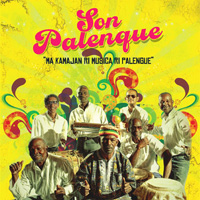
SON PALENQUE
KAMAJANES DE LA MUSICA PALENQUERA (Palenque)
I am really hooked on this hard-to-find disc of traditional drumming & African-influenced song & dance from the Central Highlands of Colombia, near their Caribbean coast. It starts with the same track as the recent VampiSoul reissue from the band, "Adios Batata," in which Son Palenque say goodbye to Batata, one of the great figures of this music. That track you can hear on YouTube or even Soundcloud. Son Palenque keep the traditional Afro-Colombian scene vital. Hearing the imported African records that young Colombians were digging, Batata (Paulino Salgado) had the brilliant idea of inviting Rigo Star from Congo to jam and the Champeta Criollo explosion hit (check out his Radio Bakongo disc on Network Medien). There are also elements of Konpas and Zouk from Haiti and Martinique in the mix. And by "Zamba," track 3 of this explosive album, we are deep in the groove. Sax and percussion are used sparingly. Then the "big boss radio" sound comes in to introduce "Ita Cole," and we are in the home stretch, with bright soukous guitar and horns, trap drums galloping giddily into a konpas beat.
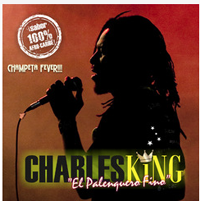
CHARLES KING
CHAMPETA FEVER (El Picó Producciones)
This is pure, unadulterated champeta, so it has the Caribbean mix that sounds like merengue, bachata and of course the added ingredient soukous to make it fizz and overflow. You may know King from Champeta Criollo vol 2, here he is in his own space. The songs are simple dance anthems with martial drumming and speedy picked guitar. King, who comes from San Basilio de Palenque in Northern Colombia, has written more than 200 songs in his 25 year career. His long-time band, Los Inteligentes, are tight. They have run the gamut of reggae, Haitian, various African rhythms and many other styles on their way to champeta criollo, the unique Colombian smokers' mix. The album was produced by Richard Blair (Sidestepper) so has clean production values. There's added horns on some cuts, organ on another, "El hueso pelao," in which he urges us to do the "Kwassa kwassa." On the bubbly "Bicarbonato" he calls out "Dally Ki," presumably indicating the presence of Dally Kimoko -- Unless it's just an invocation, like Congolese bands calling out to Dally's former partner "Shaba Kahamba" to encourage their bass players. This is a fine addition to the Colombian shelf which, though it is short, is packed with music of the highest calibre.
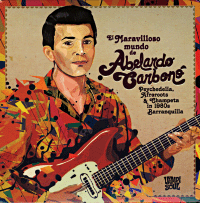
ABELARDO CARBONO
EL MARAVILLOSO MUNDO DE (Vampisoul CD [or 2LP] VAMPI141CD)
At a suggestion from Etienne Sevet, Lucas Silva of Palenque Records went digging and turned up the father of Champeta, the Afro-Colombian music that fused Afrobeat, Highlife, cumbia, and Haitian compas into a whirling psychedelic whole. This artist was on the Vampisoul Palenque Palenque compilation, now he gets a whole album to himself, and it is a smash hit from front to back. According to the booklet, by Sevet (who made a documentary about the search for the artist), Abelardo Carbonó grew up in Barranquilla in the 1960s. There wasn't much going on so he joined the police force (a job he "wasn't very good at" as he was afraid to use his gun and was even scared of dogs) while learning guitar with his two brothers. If you like that bright tropical guitar sound that we heard on the Peruvian reissues (as well as a lot of Caribbean music), you will find it high in the mix here. In fact, on "Muevela," you can hear where those psychedelic cumbia guys in Peru were getting their source material. There are suggestions of Tom Zé as well as Lee Perry in this heady blend. So as well as a tight band there are, occasionally, lots of studio effects at work, with echo, delay, vocal trickery and probably multi-tracking on the guitars, though they could be this good if they played live a lot (after all the guitarists are brothers). "Schallcarri" is their take on Fela Kuti's "Shakara"-- a massive hit in Barranquilla and all along the coast of Colombia. Other African influences range from Sam Fan Thomas to Lokassa ya Mbongo to Ernesto Djedje. The percussion is unexpected (cajón) and delightful, the chorus too provides some interesting moments where you think there are bird calls in play or Donald Duck ("La Negra Kulengue"), or else the backing singers have been huffing gas. They are sweetly harmonious in contrast to the often deadpan sounding gruff lead vocalist. There are many wonderful breakdown moments where Abelardo's guitar start inverting the riff and playing off the steaming percussion (the kit drummer loves attacking the hi-hat with his sticks while pumping it with his left foot). There's even accordion! People used to laugh at accordion but it can be perky and lively in the right hands. Here it is used on the acoustic "Ején en accordéon" which is a cover of Super Negro Bantous' "Help Yourself," which was a massive hit in Colombia. If your idea of fun is "spot the intro" you will dig guessing the references to Anglo-American pop songs in the acoustic guitar intros to the songs (wait, was that Led Zep or Mamas and Papas -- or Papas Fritas?). You may not know too many Colombian musicians' names, but the great Michi Sarmiento appears on sax (multi-tracked), and his presence lends a definite feel of konpa to the song "Se acaba la paz." "El Baile del Indio," on the other hand, has a makossa beat.

SYSTEMA SOLAR
LA REVANCHA DEL BURRO (InterMundos)
Those irrepressible fools from Barranquilla are back with their techno carnival. They call their sound "future primitive" as it is a mix of old and new. Instead of cumbia their base is champeta criollo, which is the Colombian take on soukous which was brought to their shores by sailors who always have Fela Kuti and Diblo Dibala records in their kit bags but can't play them on the boat because of the motion (I am guessing this). Anyway those much-coveted African albums became the basis of a new type of music which was patched together with drum machines and synthesizer beats. There is even the nostalgic sound of old radio deejays announcing the next song. This group uses the big sound system as a launching pad for wild vocals and complex rhythms with a big-ass heavy bottom. But it's as much a mission as music, says their leader Juan Carlos Pellegrino. In fact one song, "Machete," deals with GM food since the government mandated that only Monsanto seeds can be sewn in the country! The machete is the farmers' traditional too for clearing land, and dealing with snakes. We can only hope that thousands of these machete-wielding Colombians will show up at the Monsanto offices soon. There is a constant sound-clash vibe here, with samples, different vocalists and different styles taking center stage by turn. For me it doesn't live up to the promise of their debut. The most like their first album is the all-out "El botón del Pantalón MCDJ" and it really revs up, demonstrating they are having a lot of fun. However, in the end, the head-bangers' ball gets a bit too much for these old bones.
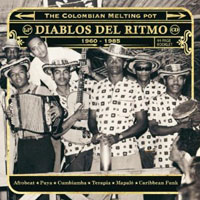
DIABLOS DEL RITMO
THE COLOMBIAN MELTING POT 1960-1985 (Analog Africa no 12)
Among labels that have discovered Colombian music recently, Soundways has scratched the surface of this culture that is one of the richest in the Americas, but they have not always made the right choices. Their Cumbia CD is late to the party: the Disco Fuentes archives yielded a great set on World Circuit in 1989, which has recently been reissued as a double CD, and, if you want more, there's a three disc set called Ola Latina that came out on the OLA label in 2006. But here's something completely different. Instead of going for the familiar hits of the Latin Brothers, Joe Arroyo, Alfredo de la Fe, Gabino Pampini and Lisandro Meza, Samy Ben Redjeb the redoubtable force behind Analog Africa, has sought out Calixto Ochoa, Wganda Kenya and lesser-known artists who delivered variations on the familiar with Afrobeat, Caribbean Funk, Porro, and other Colombian styles like Cumbiamba, Terapia and Malapé. Samy has been visiting Barranquila for the past five years looking for connections between home-grown music and imported sounds from Cuba, Nigeria, Ivory Coast, and Congo. In this collection, boiled down to 32 tracks, he showcases Afrobeat, Afro-Funk and Psychedelia on disc one, and a variety of tropical sounds on the second disc. My favourite on the second disc is a real oldie: J. Alvear's "Cumbia Cincelejana," which reminds me of Cab Calloway-era American jazz, rendered with a Cumbia beat. Samy plumbs the depths here. The result is action-packed with stimulating sounds and nary a slack track on the front or the back!
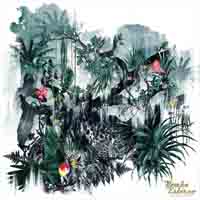
BOMBA ESTEREO
ELEGANCIA TROPICAL (Polen Records)
Every year I wait for the big summer hit to come along. Sometimes it doesn't come right on time -- but the hit shows up eventually, even if there's no summer. It should be bright and upbeat, poppy and loud, and not meant to last forever, but insistent enough to get under your skin like a bad case of chiggers. This year's winner is the new Bomba Estereo disc: a great itching pelt straight outta Bogota. Their third album -- electronica with bits of techno, dubstep, rap, reggae -- is a real mix of tropical sounds. It comes close to last summer's hit "Fuego" a couple of times, but that was really a once-in-a-lifetime track. In the new album, cumbia and chiche are the featured flavas. "Chiche" is spanish for easy, which must refer to the ease with which they build a groove and set it loping off into the depths of the subwoofer. The line-up is unchanged: Liliana Saumet on vocals, Simón Mejía on programming and bass guitar, Kike Egurrola on drums, and Julián Salazar on guitar. I got an advance unfinalized copy so I was playing with the sequence & thought the trippy instrumental "Caribbean power" made a nice overture, but it's place is in the middle. So after a brief intro we get to the main dish: "Bailar Conmigo (Dance with me)" is the most like "Fuego," and has a mid-point turn-around break that almost sounds like Bhangra; the Duchess says it made her think of Jean Michel Jarre (shudder). Well, there is goofy synth on this one. Then surf takes us to a tropical shore for "El Alma y el cuerpo (The Soul and the body)," which is the first single off the album, complete with a sweet video; and so it flows on into the next track and the next one. It gets a bit raucous towards the middle, so prepare for a marathon dance session rather than an easy skank with a few energetic bursts. "Rocas featuring Bnegao" is my least-favorite: it's a bit too generic hippy hoppy for me, and "Caribbean Power," when you play it loud, is a bit too reliant on synthetic noise, but it finally gets back in gear on "Pajaros (birds)," cools down for "Lo que tengo que decir (What I have to say)," which is almost a ballad, and then ends with a bang with "Pa respirar (breathing)." I don't watch MTV but I gather they have named them "Best New Band in the World!"
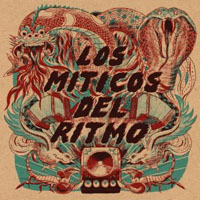
LOS MITICOS DEL RITMO
LOS MITICOS DEL RITMO (Soundways SNDW 036CD)
Will "Quantic" Holland is back with a new album of Cumbia, recorded "live" in the studio in Cali, Colombia on analog equipment and sounding, for all that, like a classic lost album from the 1960s, the heyday of the sound. It's all instrumental, with cover versions being the highlights. These include "Otro muerde el polvo (Another one bites the dust)" which, come to think of it, was remade once before on accordion as "Another one rides the bus" by Weird Al! There's an entertaining remake of the Abyssinians' reggae classic Satta, called "Satta Massa Cumbia," and a Michael Jackson entry: "No pares hasta tener lo suficiente (Don't stop 'til you get enough)." There's a fair bit of variety in here, the horns on "La Libanesa" are exceptional, and "Quantic" has obviously been immersed in this for some time; he recently produced the double-CD The Original Sound of Cumbia for Soundways, after spending 5 years looking for old porro and cumbia albums in dusty Barranquilla basements. Gildardo Montoya's "Fabiola," which was collected there, is covered here, if you want to comparison shop. (In answer to Soundways' foray, WorldCircuit have reissued their two cumbia comps from 1989 as Cumbia Cumbia vol 1-2, which I highly recommend.)
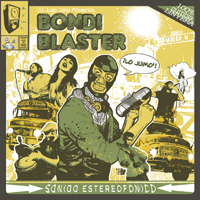
BONDI BLASTER
¡LO JUIMO'! (Strongholdsound)
This is an(other) addictive cumbia EP. It doesn't need a "Play it Loud!" sticker because instinctively you will turn it up. There are five songs on the "A" side and five on the "B" side. The latter is three remixes of one song and two of two others. More than that I cannot tell you because it has really shitty graphic design that prevents you from reading it. The two-tone "garbage aesthetic" is fine, but it's so low-tech it's painful. Juan Data is a producer of sample-based music in a style that he calls "cumbia linyera" ("linyera" is Argentine vernacular for garbage pickers). In this new cut-and-paste ensemble, conjured in association with Dub Snakkr, Juan Data mixes cumbia, Brazilian pop, electronica, rap, and Andean folk (he could have left off the latter) to create a new type of hip-hop. The disc starts with "Larvasaurio's Revenge," which coasts along to get the juices flowing and your limbs loosened up, then we get a sample of Systema Solar to warn us of the coming storm. The jump-out track is "Cumbia Nena," which works out the subwoofer. Listen to it on their site or here and you will agree.
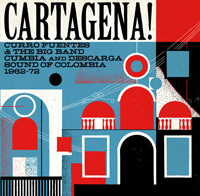
CARTAGENA!
Curro Fuentes & The Big Band Cumbia and Descarga Sound of Colombia 1962-72 (SOUNDWAY)
In the late 80s GlobeStyle started licensing Colombian music for the European market. In 1989 WorldCircuit released the impeccable introductory comp, Cumbia Cumbia from Discos Fuentes. In 1990 Island/Mango leased a smoking set called Tropical Sounds of Colombia from the same source. Both were sampled for the excellent soundtrack to John Sayles' film Men with Guns, and set us on a quest to find Lito Barrientos and others. Soundway's latest 2-disc set is called The Original Sound of Cumbia, assembled by Will Holland. I am sorry to say I was underwhelmed by it. But rather than dwell on that sprawling and drab CD package, let me point you to another, better Soundway release from last year. Cartagena! appealed to me right away because of its vibrant retro cover. This is a packed hour of big band cumbia from the 1960s. There's boogaloo too, but the flavor of salsa suffuses the mix which is drawn from the archives of producer José "Curro" Fuentes, youngest member of the Discos Fuentes family who had his own Discos Curro imprint. This album has an easy flow and grooves from one loping riff to another. There's piano and accordion, wild clarinet flares up, the bass bomp bounces around between scraped and tingled beats, as herds of brass await their moment. Trombone challenges the bass while muted trumpet says, it's my turn, elbowing aside the saxes. As usual if you scour the web you can find some of the tracks to sample. Here's the opener, "Me voy pa la costa" by Rosendo y su Banda on Soundcloud. The rest is up to you.
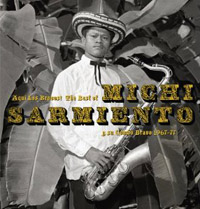
MICHI SARMIENTO
Y SU COMBO BRAVO 1967-77 (Soundway SNDW CD028P)
I always had the feeling the English, with their famous reserve, were afraid of salsa: it let too much hang out and was a little too impassioned for their starchy dancefloors. However Soundways (UK) has dug into the crates and pulled out a raging set of Colombian descargas that lit up the red-light district of Cartagena in the 70s. Salsa was right at home in Colombia. My favourite salsa band, The Latin Brothers, is from there. In the late 60s the latest wrinkle from the New York salseros was Boogaloo & it was gobbled up in the port cities of Cartagena and Barranquilla. Discos Fuentes is the main salsa label in Colombia and their arranger Climaco had a son named Michi who was a talented sax player fronting a group of Bravos. Here are 16 of his best three-minute danceable work-outs: cumbias, descargas and guaguancós that unravel a skein of magic. The sax and horn arrangements are fine but there is also exciting timbales (on "A los Sicodelicos") & a romping piano on "Mirame San Miguel." On "El Negro y Rey" a repetitious violin jumps into the mix with the timbales and sax and blows the proverbial lid. The percussion and vocals are occasionally harsh, as they would have to be to be heard above the din in a port-city bar, but that's how we like it.
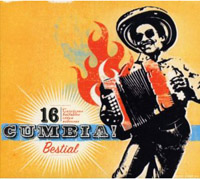
CUMBIA BESTIAL (Chusma Records)
From the label that brought us the outstanding Systema Solar comes this compilation of Bestial Cumbia! It's a grinding, crunchy, rough and ready set of really hard grooves. Accordion samples and brass snippets are woven into tough textures with punchy bass and sharp drum riffs. Systema Solar make an early entry with "Ya veras" which almost fetishizes the surface scratches and tape bias of old samples. The deliberately off-kilter sing-along chorus counterbalances the lyric vocals and chiming lead. This tasty cut is followed by the biggest hit of the year, "Fuego" by Bomba Estereo. And there are other strong entries here: A hip-hop version of "Cumbia, tabaco y ron" is sweaty and almost gives you a booze-and-smokes headache. "Alta yama" by Miss Bolivia has awful synth but then a reggaeton drumtrack and a trombone lead redeem it. But we suddenly switch to "Pan con vino" by Master Blaster and our heads are swimming. Things get weirder, on "Half Mex. Half Colombian bandit," DJ Toy Selektah samples what sounds like a Jamaican talking, then the electrocumbia takes over. You can check out the vertiginous video on Youtube. There are a couple of flatter moments where you stop listening and it fades into the background, but then Copia Doble Systema does a remix of the classic "Colegiala" in a slowed-down stoner dub version that is really engaging. A Kraftwerk-inspired "La Guajira" by El Remolón is less memorable. The last track "Aguanegra" by Frente Cumbiero sounds like it could be from the Ethiopiques catalogue, apart from the button accordeon wheezing away. This is one smoking collection.
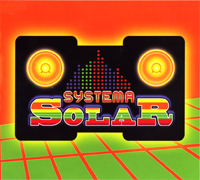
SYSTEMA SOLAR
SYSTEMA SOLAR (Chusma CR002)
This one leaps out of the speakers and grabs your vitals! Looking for things to fill the soukous void under my dancing feet I find the Colombian sound systems are really fitting the bill (& the cover design is bad enough to convince you of its legitimacy). Colombian sound systems are mobile, often pulled on donkey carts to move the massive speakers. Champeta is the raw ingredient, to which they have added scratching on old (truly scratchy) 1940s LPs, DJ toasting, with the exaggeration diction of r-r-r-r-r-r-adio announcers! and drumming and samples. This kicks off with wild enthusiasm and a track called "Bienvenidos" where they repeat "Systema Solar" over and over, against a pulsing bass, samples, scratched records and a wailing organ. "Mi Kolombia" starts in the street and layers on accordeon samples and a sickly wheezy funfair whirl of vocals & effects. It's ill and I love it. "El Majagual" features wild flauta de millo, which is a native instrument like a shrill reedy pennywhistle. After fifteen minutes it slows to a ballad then a techno ditty, called "Chico," that is skippable. But they are not giving up yet. What sounds like a souped-up Calypso oldie called "Firewire" is remade as "Fayaguaya." The live horns and vocals on this are fine. A dubby kind of thing --"Oye"-- follows that is okay in the flow because you are ready for a break. Speaking of flow it sounds like it's underwater. We stay in trance space for a while, with a fine clarinet popping up in "Amenaza." Then they wake up for a big finish with "Ya veras" and "Quien es el patron?," both back in the sh*t-kicking champeta mode. Overall Systema Solar's debut disc is well-sequenced & most enjoyable.

PALENQUE PALENQUE
Champeta Criolla & Afro Roots in Colombia 1975-91 (SOUNDWAYS CD/LP022)
Like the VampiSoul CD I reviewed last time, this collection of Afro Roots shows more than some Caribbeanized African riffs: there are many currents at work in this mix. However the tracks by Son Palenque do indeed sound African. Plus Wganda Kenya are back with their unique Afro-beat sound (complete with Moog) in three solid tracks. The music comes from the north coast of Colombia where the sound systems of Cartagena and Barranquilla played a big role with their quest for novelty and introduction of African tracks on vinyl brought in by sailors. As in Jamaica, with their dueling sound systems, the DJs would scratch out the labels and promote their individuality through the unique tracks they had acquired. These tunes were picked up by local musicians who added their drumming and vocals to the melodies, or adapted the spirit of the new sounds to traditional African folk songs that had survived from slavery days. But the subtitle of this set also includes Champeta Criolla which is how we know the music today and this sampler goes beyond the Discos Fuentes label to find a wide array of artists doing their version of the African groove. Even Lisandro Meza, well-known as a Cumbia artist, turns in a creditable Fela knock-off with "Shacalao." Meza's accordion fits right in: in fact when he toured Angola he said that the Indian laments he plays have always been underpinned by African drumming on his records. Other outstanding tracks include La Nelda Pina, with "El Sucusu," Wganda Kenya's "Pim Pom" and the equally insistent and trance-inducing "Tungalala (el sapo)" by Son Palenque.
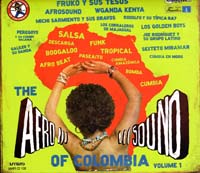
THE AFROSOUND OF COLOMBIA (VampiSoul 108)
Bonnier Amigo, Soundways, and now Vampi Soul have gone to the vaults of Colombia's famed Discos Fuentes looking for funky and hot Latin tracks to excite our certainly jaded palates. You've heard of old wine in new bottles, which is a concept I never grasped: old wine should stay in old bottles 'til it's ready to be drunk -- however, this is another random sampling of some smoking Colombian salsa gathered together under the supposed umbrella of their mutual African-ness. I don't get that part. Colombia's rich musical heritage certainly derives from Africa and also, equally, from Cuba and its other Latin-American neighbours, but it's an excuse to gather some hot cuts from the 60s and 70s by lesser-exposed bands, which is fine by me. Fruko is the best-known artist on here, indeed he was not only the bandleader of his Tesos (Tough Guys), and the Gold Standard of the label, but also the producer of the entire catalogue, and so his musical sensibilities were at work when he selected bands for recording. We get the best of Boogaloo, Bomba, Salsa, Cumbia, Funk and what you might called Afro-beat, which is really a Nigerian genre, except when performed by Wganda Kenya, who sound as good as anyone from Lagos. Wganda Kenya really do sound African. Apparently they were a studio band, assembled to cover non-Salsa sounds for Discos Fuentes, as music from Martinique, Curaçao, Nigeria etc was also popular with the Cartagena sound systems. There is a band called Afrosounds on here, with some tracks that could also be mistaken for African recordings in another context, such as one of those Beninois bands, like Los Dadjes, doing Latin covers: O, what a tangled web we weave! Their "Carruseles" and "Ponchito de colores" are stand-outs. Fruko also shows how it's done with his masterful rendering of "Lamento Cubano" by Antonio Machin from 1930; it was the basis of many Colombian salsa grooves in the 70s. Sus Tesos also perform "Maria la O" an operatic song by Ernesto Lecuona. There's a really dated "Cumbia del sal," played on a Moog, but it works -- in a trashy glitterball way. The Moog-player also dribbles all over the Wganda Kenya sides, including a dire cover of "(Everybody was) Kung-Fu fighting"! There are barking dogs, swannee-whistles, all sorts of silly things going on, but underneath it all, the mad urge to shake it, shake it, but don't break it. Incidentally, there is no overlap with the Soundways disc if you think you have it all already. So boogie down.
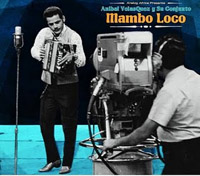
ANIBAL VELASQUEZ Y SU CONJUNTO
MAMBO LOCO (Analog Africa AALP067)
Like his counterpart, Miles Cleret at Soundway Records, Samy Ben Redjeb has jumped from West Africa to Central America for his latest release. One of the things I relish about Analog Africa (& Soundway too) is the deluxe packaging that accompanies their CD releases. I received an advance copy of Mambo Loco lacking this part which makes it harder to review. Velasquez, known in Colombia as "El Mago (the Magician)" is an accordion player who peaked in the 60s with the popularity of vallenato music. Hailing from Barranquilla he started out as a session man until he was able to form his own band in 1952 and he recorded something like 300 LPs in his career. The music was highly influenced by Cuban guaracha, but in addition to the driving accordion lead, the percussionist replaced the skin-covered hand drums with heads made from X-ray film to create a sharper sound. There's fiery piano and the kind of attack you expect from Colombians, though this is from the easy-going pot era as opposed to the coked-out modern times. The guitar-led "Los Vecinos" gives it away as a Guillermo Portabales knock-off. More piano drives "Cecilia," then the accordion arrives on "Mi cumbia," with a washboard rhythm. The heat is on for "Que paso," and does not let up. You can see why it appeals to DJs. Fans of Latin music will dig the diversity of rhythms and instrumentation.
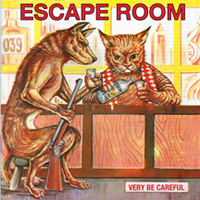
VERY BE CAREFUL
ESCAPE ROOM (Barbès Records)
You'd imagine that all the youngsters in Colombia are into hip urban sounds like Reggaeton or Champeta. And then you wonder if Colombian salsa is dead and what about other more traditional sounds? Turns out there's a group of youngsters in Los Angeles who have rediscovered their roots in Vallenato, that's the wheezy loping accordion music, a sleepy Cumbia that's had one too many. Indeed the singer is straining like he's trying to remain upright as the cowbell creates a reggae-like skanking off-beat. By track 3, "La Alergia," they pick it up to almost a Cumbia-like tempo as the accordions clash in ghostly counterpoint, one playing the chords, the other hitting unresolved minor keys. The percussion creates a hypnotic drive as the old classic sounds are infused with punk dance-all-night energy. The bassist and accordion-playing Guzmán brothers formed the band in 1988. To keep it in the family their poet mother writes a lot of their lyrics. Being from LA they are surrounded by La Gente de Aztlan, people from all over Latin America who make Southern California their home, so their fan base is Chicano & gringo as much as Caribbean.
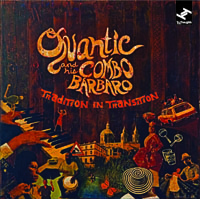
QUANTIC & HIS COMBO BARBARO
TRADITION IN TRANSITION (TruThoughts TRU CD190)
IJ mentioned this to me. I checked out the Youtube videos and decided it was worth buying the album. Quantic also has five albums out with his funk band the Quantic Soul Orchestra and several solo albums, so he is a big deal, in Europe, if not in Colombia. Cali, his adopted home, is close to the sea and therefore the proximity of Cuba and Puerto Rica has enriched the musical traditions alongside marimba and other ancient African instruments brought over by slaves. But the oddest import is Quantic himself, who is none other than guitarist/songwriter/producer Will Holland from England. He has adopted Cali as a second home and put together some top flight salsa musicians such as Peruvian pianist Alfredo Linares, who is all over the album with his conguero Freddy Colorado & swinging baby bass player Fernando Silva. There are folkloric elements and there is even a Brazilian string section overdubbed in Rio. The arrangements are great. I showed the YouTube video of "Un canto a mi tierra" to the Duchess and she remarked that Nidia Góngora's voice was too shrill, but she admitted the music was smoking. I love the trombone on this, as well as the bustling percussion. And Holland, er Quantic, himself has got that "Soukous-goes-to-Cali" guitar part down pat. Though the disc arrived too late to be considered for my best of 2009, I think I will be playing it well into 2010. Góngora only sings on one track. On "I just fell in love again" we have the Soul Orchestra sound, big band funk, with the multitracked horns doing a Mussel Shoals behind Panamanian vocalist Kabir Malik. He also sings (in English with a great deep voice) on my favourite track "Linda Morena," a salsa funk workout, which has Angel Hernandez playing muted trumpet and Lucho Blanco on baritone sax. "Cançao do deserto" takes us off to North Africa for a mellow interlude. And "Albela," sung by Falu Shah, I thought really was middle eastern or Ethiopian. A lot of variety on here, with the emphasis on small combo salsa in shades of funk & jazz.
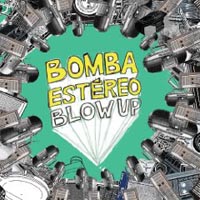
BOMBA ESTEREO
BLOW UP (Nacional Records.com)
This comes from the LA-based label that brought you Bostich and Los Fabulous Cadillacs. It's dance music with bits of disco, hip-hop, electronica, reggaeton, etc over some vaguely traditional Latin American armatures. I don't like all of it but I am wild about the debut single (track 2) "Fuego," which starts as a cumbia then a murderous drum loop kicks in (with a bit of police siren & a rocket-launch countdown) & layers of organ, bongo, bass drum and bass guitar fill it up to overflowing. On top of it Li Saumez delivers the "voz" as she does on most of the album. The loops, bass guitar and arrangements are by her partner Simon Mejia. There are two percussionists completing the line-up. I am not sure what it is -- champeta meets reggae meets house -- but whatever it turns out to be, Colombia is on the cutting edge of it. The new transglobal dance sound maybe. You can check out their sound and vision on myspace or youtube.
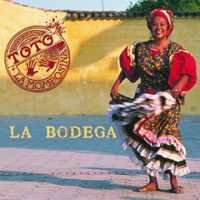
TOTO LA MOMPOSINA
LA BODEGA (Astar Artes 44 1548 821767)
Totó is back. She even came through town during the summer and I would have gladly paid to see her but she did a free concert at Stern Grove and I refuse to go there after enduring the driving/parking/obnoxious crowd scene one too many times. So I have to imagine her show, and this new album is guaranteed to make you feel you have been whisked to a warm bodega in some little coastal Colombian town. Totó is well-known internationally as a folklorist who has preserved the traditions of her country, including African and native rhythms as well as imported Spanish ones that melded into the cumbia, bullerenge, and other dances. You even hear the Paul Simon/Peruvian pan-pipes on "Margarita." The set is familiar (showing continuity with her other discs): she is in fine voice and her band are tight. Her band, Los Tambores, owe a lot to Batata, their original drummer, who grew up in Palenque de San Basilio, a town founded by escaped slaves who had their own language. The legendary Batata (a.k.a. Paulino Salgado, who died in 2004) brought his drumming to her Tambores and introduced her to the bass marimbula, a cousin of the African thumb-piano. Los Tambores incorporate a lot of African ritual drumming into their sound, and you will even hear invocations to Shango, as in the pulsing "Tembandumba." Twenty years ago Totó moved to Europe and made a splash at WOMAD, followed by an album on Peter Gabriel's RealWorld label. Since then she has only put out albums intermittently, on ASPIC, World Village, Indigo, and other small European labels. So you have to find them where you can. Astar Artes is a UK-based label specializing in Colombian and Cuban music. On "Duena de los Jardines" her versatile band show what they can do: It's an all-out jamb-kicker, but they rein it in too soon. Guitar and tiple lead the way in "Fiesta Vieja," while the brass punctuates the refrain. At 40 minutes, this disc will leave you wanting more.
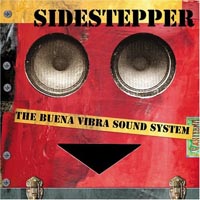
SIDESTEPPER
THE BUENA VIBRA SOUND SYSTEM (PALM CD2138)
Not a moment too soon, here comes the big hit of the summer. This is the fourth Sidestepper album but the first one to cross my path. It's the brainchild of Richard Blair, an English mixologist who worked with the legendary Toto la Momposina, and went to Columbia in pursuit of those elusive blackbeats. He ended up putting together a band that comprised Latino musicians from the town with Black musicians from the hinterland. Normally the two races don't mix. Blair, formerly an engineer for Peter Gabriel's RealWorld label, has the necessary credentials and patter to get these people to join forces and produce a smoking set. This is hot. You remember how Tom Tom Club took the Sugarhill Gang sound and made it palatable to white kids in the 80s? Well, now that same sound has been revamped for the modern dancefloor on "Deja soft." But let's rewind a bit. We start with a bit of distortion, like a song from the radio taped on a warped cassette to suggest something vital and barely grasped from the air. Then the flanged sound warps into a background fill as bass, drums and electronica fight their way to the top with some snatches of vocal, for a catchy number called "Mas papaya" (Lightning Head remix). Somewhere in there we hear a Columbian melody. This slides into "Que sera," a wickedly catchy song with accordion samples and a persistent reggaeton-like chorus. It all flows beautifully into the big moment, "Deja soft," which starts out tentative and dreamy, half-resolved, then a minute in we get the Tom Tom Club/Sugarhill A-minor to F vamp, simple and seductive. Headbangers rejoice! Towards the end, things chill a bit: "Hoy tenemos" has some great piano, with snatches of Gershwin & Bacharach. One caveat: don't go looking on YouTube, because the Sidestepper videos suck. They are so depressing you will be put off the music!
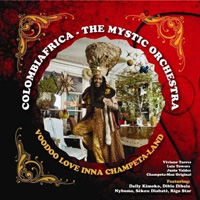
COLOMBIAFRICA - THE MYSTIC ORCHESTRA
VOODOO LOVE INNA CHAMPETA-LAND (World Network/Riverboat TUGCD1035)
Champeta is one of those great musical hybrids that was destined to happen. I think it was at a music festival in Barranquila in the mid-80s when Diblo jammed with Juan Luis Guerra that the idea took hold in a major way, but before that there were deejays in urban corners of Colombia spinning Fela & Prince Nico Mbarga albums and local drummers jamming along. Now the inevitable has happened: an actual collaboration where Congo meets Colombia in the studio. The impetus was the visit of Colombian producer Lucas Silva to Paris where he met soukous greats Dally Kimoko, Diblo Dibala, Rigo Star, Caien Madoka and Nyboma. He ran into Sekou "Diamond Fingers" Diabaté, founder of Bembeya Jazz, who sang him the opening of "Malanga," a Cuban song beloved by Colombians. Silva knew he had to pursue this collaboration, so he brought three singers from the town of San Basilio de Palenque, Justo Valdez, Viviano Torres, and Luis Towers, to Bogota and teamed up with Congolese composer/guitarist and legend Bopol Mansiamina & Camerounian drummer Guy Bilong to put together the Mystic Orchestra. Then the African musicians were recorded in Paris. This is the best Congo-Caribbean infusion since Eddy Gustav's "Adans on surboum Isabelle." There's more touches of the sound system madness from the earlier Champeta albums but now the soukous part is much more apparent. The rhythms are mostly merengue, and the soukous guitar fits perfectly with the back-and-forth lyric sway and four square bomp of the kick drum. The liner notes also mention cumbia and bullerengue. The last track is a rootsy batata: a true Afro-Colombian groove. There's a cover version of Bopol's "Jaloux Jaloux," (a.k.a. "Pitié, je veux la reconciliation") one of his most sublime hits, done in a sprightly uptempo salsa style with horns, Rigo on solo guitar and Nyboma singing. The Palenqueros' influences include Empire Bakuba, Soukous Stars, Soul Brothers from South Africa, and Coupé Cloué from Haiti and they manage to blend elements of all of them with great success into their sound.
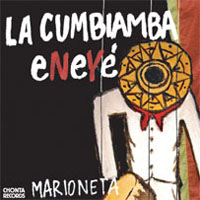
LA CUMBIAMBA eNeYé
MARIONETA (Chonta Records CHON003)
Fine, raucous Cumbias and jazzy fun from a group of Colombian expatriates who have made New York their home. The CD hits the ground running with a fast-working bass and blasting bombardino solo by Rafael Malkiel. The bombardino is a euphonium but sounds quite like a trombone. There's a short burst of soprano sax then it breaks down to hand drums for a few bars. The album veers between these jazzy tracks and some more folkloric ones with flute and bass drum of the Andean "El Condor pasa" type that I don't like as much. But there's variety and many bright moments. "Chicharrón peluo" sounds more like Mexican brass band music with its boisterous hiccuping beat and thick brass. The brass arrangements are really interesting with the bombardino working a contrapuntal bass and tightly arranged descants behind the vocals. There's a taste of marimba but the emphasis is on Afro-Colombian traditions and particularly small town marching bands that would hold you spellbound if you came across them in situ (--or in Bogota for that matter!). However the skill of the musicians is apparent and it transcends mere folkloric recreations and creates something new and thoroughly engaging.
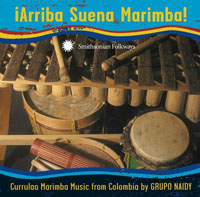
GRUPO NAIDY
ARRIBA SUENA MARIMBA (Smithsonian Folkways 40514)
This is Currulao marimba music from Colombia: African music that has survived in the New World and is preserved in the rainforest of Colombia's Pacific Coast where blacks hunt, fish, pan for gold and make music. It's not quite as idyllic as it sounds when you consider the reality of life in Colombia. Currulao encompasses at least half a dozen different types of music, many of which are presented here. Smithsonian has found a group who are prime exponents of all the musical forms that accompany storytelling and songs. The 24-bar wooden marimbas are suspended from the ceiling (in special spacious marimba huts) over bamboo resonators and played by four hands. They are accompanied by percussion and croaky women singers. There are two large bass drums, beaten and struck on the side, two conga-like smaller wooden drums with deerskin heads. The players also stamp their feet in time to the music while the singers shake bamboo tubes filled with seeds to add a counterpoint. The women singers write many of the songs, particularly the religious ones, which involve catholic saints, and lullabies for children. The Smithsonian Institution (which acquired Folkways from the estate of Moses Asch in 1987) is doing a fine job tracking down and documenting some of the great overlooked music on the planet. Not surprisingly, it reminds me a lot of Toto la Momposina, but I mean that as the highest compliment.
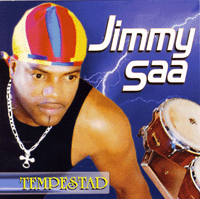
JIMMY SAA
TEMPESTAD (Fonocaribe CDNA 110243)
Right from the get-go you know this is going to be good. It starts with a clutch of congas and vocals: Jimmy Saa singing and also playing. Then a big horn ensemble punches in and soon the dancefloor is packed as the glitterball in your mind lights up. Deejay IJ found this one used and loaned it to me. It came out in 2004 and features Saa, one of the singers from Grupo Niche, with another excellent Colombian vocalist, Yuri Buenaventura, on coro. The message of the album is "después de la tempestad viene la calma," so there is a nice balance between freaking-out trumpet solos and laid-back bajo and bongo. It's a big band, with nine guest backing vocalists, three trombones, three trumpets, baritone and flute. There are also three pianists and three bass players listed so I guess that means there were different men at each session and three sessions, but despite this it makes a coherent whole. I could do without the synthesized strings but there are great breaks, excellent horn charts, and some fine noodling by Marino Calcedo on guitar.

YURI BUENAVENTURA
YO SOY (Mercury, France)
From Colombia, by way of France, comes a slamming new recording by Yuri Buenaventura, titled YO SOY. It's mostly straight-ahead danceable high-energy salsa. There's an interesting track called "Salsa Rai" that is a duo with an Algerian artist called Faudel, and features violin that goes from charanga to Arabic plaint. It is followed by a piece of Afro-Colombian ritual music known as a Currulao called "Tito", that has marimba, percussion and voice, and by rights should be the concluding piece of the album. But it's not over. For ten cuts this album really delivers. Then, sadly, things go off the rails with a horrendous cover of Elton John's "Your Song" called "Tu cancion," a wretched excuse of a ballad. Though the last track is back to form, I was so put off by the lame Elton John number that it spoiled the album for me. However, I'll keep it and certainly play the first ten cuts.
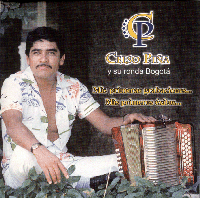
CELSO PINA Y SU RONDA BOGOTA
MIS PRIMERAS GRABACIONES ... MIS PRIMERAS EXITOS (BMG 74321-88257-2)
This came out in 2001 but is new to me, "the first recordings and first hits" by the young button accordeonista from Bogota, Colombia, Celso Piña. His terrain is the rich tradition of cumbia and he comes on strong with an earnest voice and a solid band. There's acoustic guitar and a booming bass and percussion with a relentless cumbia pulse going. The terrain is familiar but there's room for interesting little sorties within it: great bursts of timbales or bongo and, by turns, a wistful or wild clarinet. The accordeon isn't to the fore particularly, though there are echoes of Lisandro Meza on some cuts. A couple of standards: "Tu culpa" by Anibal Velasquez, and the Jose Barros classic "La Piragua," are delivered with panache. I imagine these guys are club favourites in their home turf. The last track, "La Despreciada" has an African-sounding guitar which is interesting. This is not Champeta Criolla (the popular Colombian music from the wrong side of the tracks, down by the docks) but maybe has been influenced by it. Or alternately, those guitar styles were there already in the indigenous sound.
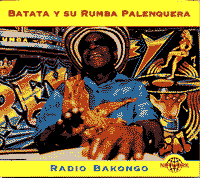
BATATA Y SU RUMBA PALENQUERA
RADIO KONGO (Network LC6759)
The biggest discovery of 2003 was a surprising sound that seemed to come from the collective consciousness of our "world beat" past: mixing Prince Nico Mbarga's highlife, wild soukous guitar, Cumbia and Merengue beats. It all added up to Champeta Criolla: raucous Afro-Colombian pop out of Bogota and Cartagena. Two compilation CDs and a solo album have come out thus far on Palenque Records and Network Medien. Batata's slamming "Ataole" was also featured as the lead off track on the CHAMPETA CRIOLLA sampler.
74-year-old conga player Batata sounds like a Cuban sonero whose had one too many glasses of rum. His horns are equally ragged until the soukous guitar played by Edgar Gutierrez pulls it together. It's called Colombian Afrobeat, which means it sounds like Nigerian pop until the accordion goes coastal on you. Wonderful stuff. Batata, who accompanied Toto la Momposina on some of her recordings and tours, died early in 2004, so this is a rarity to treasure.
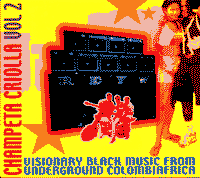
CHAMPETA CRIOLLO VOL 2
(Palenque Records PAL 1087)
After getting inspired by the Batata y su Rumba Palenquera album, I finally found a copy of CHAMPETA CRIOLLO VOL 2. This is more of the same Afro-Colombian insanity. The Afro component is not so much traditional rhythms inherited and mutated after centuries, but recent borrowings from Highlife and Soukous. Two of the artists represented cover tunes by Prince Nico Mbarga which makes me wonder, again, why he was left off the ROUGH GUIDE TO HIGHLIFE, as well as the ROUGH GUIDE TO NIGERIA AND GHANA. He was surely one of the most influential artists of the genre. The influence of the Oriental Brothers is also heard, alongside that of homegrown giants like Joe Arroyo and Fruko. This is wild, pulsing music, with soukous-influenced guitar bubbling under the surface, like a rawer version of Ricardo Lemvo and Makina Loca. The sequencing is excellent and also includes snippets of "Big Boss" radio sounds with booming reverb between tracks. For my money, this is the sound to replace soukous on the dancefloor. Even when the lead instrument is accordion there is an underpinning of heavy bass and stomping bass drum to keep it pumping. What keeps it interesting is the hybrid form. It's not just soukous générique like we started to hear from Soukous Stars, Diblo and Kanda Bongo Man, but a pan-African sound that includes jazz and Latin America touches. Even the rapping works in this context, as another element in the blend. "El Maria" by Mr Boogaloo has a droll delivery that is very compelling. Batata is still, probably, best of the lot, but here with his compadres and the clear tributes to Nigeria, you get the full spectrum of the sound. Dominican Republic meets Mbaqanga on "Mama Africa" by Luis Towers. Palenque Records have set out to chronicle this music and I urge you to buy anything you find on the label to encourage them.
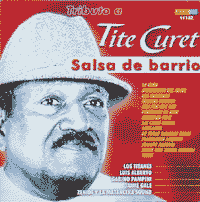
TITE CURET
SALSA DE BARRIO (Discos Fuentes 11142)
SALSA DE BARRIO is a tribute album to singer-composer Tite Curet Alonso. His songs have appeared on the soundtracks to GODFATHER II and WOMEN ON THE VERGE; he is a fan of Colombian vallenato music, jazz and Brazilian music, and his own compositions are loved all over the Latin world, including Spain. Curet is an author as well as a songwriter and has been fêted at home with honorary degrees. This album presents versions of his tunes by Los Titanes, Galileo, Luis Alberto, Gabino Pampini, Jaime Gale and Zenide y la Matancera Sound. The only song I was familiar with is his "Isadora Duncan" which has been covered by Cuban artists. In fact Zenide, who sings it here, sounds a lot like Celia Cruz. Both these Discos Fuentes have a big sound, with well-orchestrated brass punctuating the vocals, melodic coros, and high production values.
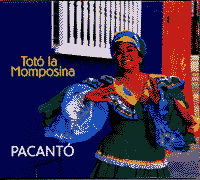
TOTÓ LA MOMPOSINA
PACANTO (MTM World Village)
From Colombia comes Totó la Momposina, whose new album, PACANTO, is released by MTM (not Mary Tyler Moore, I'll warrant) in that country and World Village in the USA. Something of a scholar of Colombian music, Toto collects folk melodies and reinterprets them with her fine band, Los Tambores. They have a street-level intensity to them and break down to raucous brass jams. "Pacanto" means "to be sung," or "for singing." I enjoyed Totó's earlier album on the ASPIC label from Switzerland which was more in the Afro-Caribbean mode. While the music has a common African ancestry with Cuban and other Caribbean styles and is often rooted in voice and guitar, it has great depth and complexity, particularly in Totó's arrangements. There is a strong black musical tradition in Colombia (there are 20 million black people in the country which spans both coasts), and there is also the rich Indian heritage. (In Cuba and other islands pirates killed off the indigenous peoples.) Totó's powerful voice featured prominently on the soundtrack of MEN WITH GUNS, which was a musical smorgasbord of Central American styles, and her presence really augmented the mood of the film. This new album covers more contemporary folk music styles. She even strays off to an Andean sound with her pre-Columbian cactus wood flutes for a song with drums and then throws in a big band cumbia for total contrast. Her music is traditional and features a rich array of material in superb arrangements. Drums, trumpets, guitars, chorus are the mainstays and her fine singing crowns it all. On the closing number, "Mami Wata" vocals are shared by Djanka Diabate and Mama Keita from Mali, accompanied by acoustic guitar.
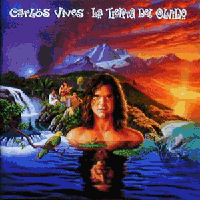
CARLOS VIVES
LA TIERRA DEL OLVIDO (PolyGram)
During my first three-month sojourn in Brasil I was getting musical fever from all the bad samba I was forced to endure. I finally heard some great music in a trendy watering hole so asked what it was: Carlos Vives' LA TIERRA DEL OLVIDO. He is from Colombia, but his album made a big impact in the whole Southern hemisphere. It was self-produced after every major label in Columbia rejected it, and sold millions of copies in Central and South America. In 1995 PolyGram issued it worldwide. (Ignore the New Agey cover art.) The title cut is a beautiful ballad about love and loss and death (How convenient that "yo te quiero" rhymes with "yo me muero" in Spanish!). It has what sounds like Peruvian pipes in it, but is basically animated by accordeon and guitar that gives a global sea-chantey sense to the beat.
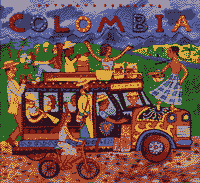
VARIOUS ARTISTS
PUTUMAYO PRESENTS COLOMBIA
The fine new sampler from Colombia, PUTUMAYO PRESENTS COLOMBIA, is too short (at 45 minutes). It makes all the right connections: Joe Arroyo, Fruko, Sonora Dinamita and the Latin Brothers, but it doesn't quite go through the roof which is where a good Colombian compilation could take you. Perhaps they are hurriedly anticipating the next move from the Rough Guide series out of England. Perhaps Putumayo's excellent A&R guy Jacob Edgar is overworked, what with flying down to Bogota one week and off to Paris the next. (What a living!) However, it's great to have both these labels devoting so much energy to helping folks find access to these diverse musics. Both Rough Guide and Putumayo have a dozen samplers each that are indispensable, and doubtless many more on the way. The Rough Guide packages are nicer because they have (relatively) clean design and are not hamstrung by the faux naif Nicola Heindl covers that Dan Storper seems hung up on. But to Putumayo's credit they get their product into boutiques and gift shops that don't normally carry music so they have a stronger visibility than other labels. (Storper started Putumayo as a clothing and handcrafts company hence the trade connections.)
Putumayo are predicting Colombian music will be the next big thing after the Cuban fad, and there's no reason why not. I would love that, but the market is pretty fickle and may just decide that the elephant xylophonists are it and soon we'll have monkey brass bands, penguin palm court orchestras and insect harpists. (Besides I bet those elephants do a lot of overdubbing.)
One of the greatest Colombian artists Joe Arroyo gives his blockbuster rendition of "Yamulemau." This is an odd song because it was written and recorded by Laba Sosseh of Ivory Coast when he visited New York. Sosseh was a pioneer of "Salsa Africana" and his album predated Africando by 14 years. When Joe Arroyo covered it he imitated the African lyrics, the way Africans often imitate English or Spanish lyrics. It's a masterpiece. Lots of cumbia oozes out of this package too; "Ciclon" by Sonora Dinamita, "Las Lavanderas" by Gabriel Romero and "Cumbia del Caribe" by Edmondo Arias and his orchestra are some of the crucial cuts on here. Another classic is Lucho Bermúdez' "Fiesta de Negritos." This virtuoso clarinetist, who died in 1994, brought big band jazz to Colombia. He created a new form of the indigenous porro rhythm which he popularized throughout the country.
One of my favorite Colombian artists is singer Totó la Momposina who collects folk music from the African palenque villages on the Atlantic coast of her homeland. There's a strong connection to Cuban son in her sound, adding another shade to the music of Colombia. Despite its brevity, this is a great album and goes on top of the pile beneath World Circuit's CUMBIA CUMBIA and Disco Fuentes' HOMENAJE A PIPER 'PIMIENTA' DIAZ.
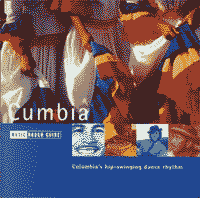
VARIOUS ARTISTS
ROUGH GUIDE TO CUMBIA (Rough Guide RGNET 1043CD)
The most famous indigenous musical style of Colombia is Cumbia. World Music Network has just issued the Rough Guide to that infectious rhythm. A blend of Spanish guitar, indigenous reed music and African rhythms, Cumbia is a dance rhythm that prefigured salsa (the name comes from Cumbé, a dance native to Guinea). Among Colombian salseros, the Latin Brothers have to be reckoned with the best from anywhere. La Sonora Dinamita have a big following in the country, as do solo artists who cover many styles, such as Lito Barrientos, Calixto Ochoa, Fruko and Lisandro Meza.
After the Second World War, the music left the coastal regions where it was still largely African-based drum and dance music, and became popular in the cities. In the 1960s Sonolux began recording the popular songs which featured guitar, flauto de millo (a clarinet made from cane), and gaita (a shrill flute). These historic recordings were mined for the present compilation which is a panoply of classic cumbias and a few porros, another African-derived dance form.
Other Colombian musical styles, such as vallenato (primarily accordion-based) are collected by Discos Fuentes on albums like THE TROPICAL SOUNDS OF COLOMBIA and their own issues of Cumbia compilations from a decade ago. THE ROUGH GUIDE TO CUMBIA is another great addition to the Caribbean shelf.